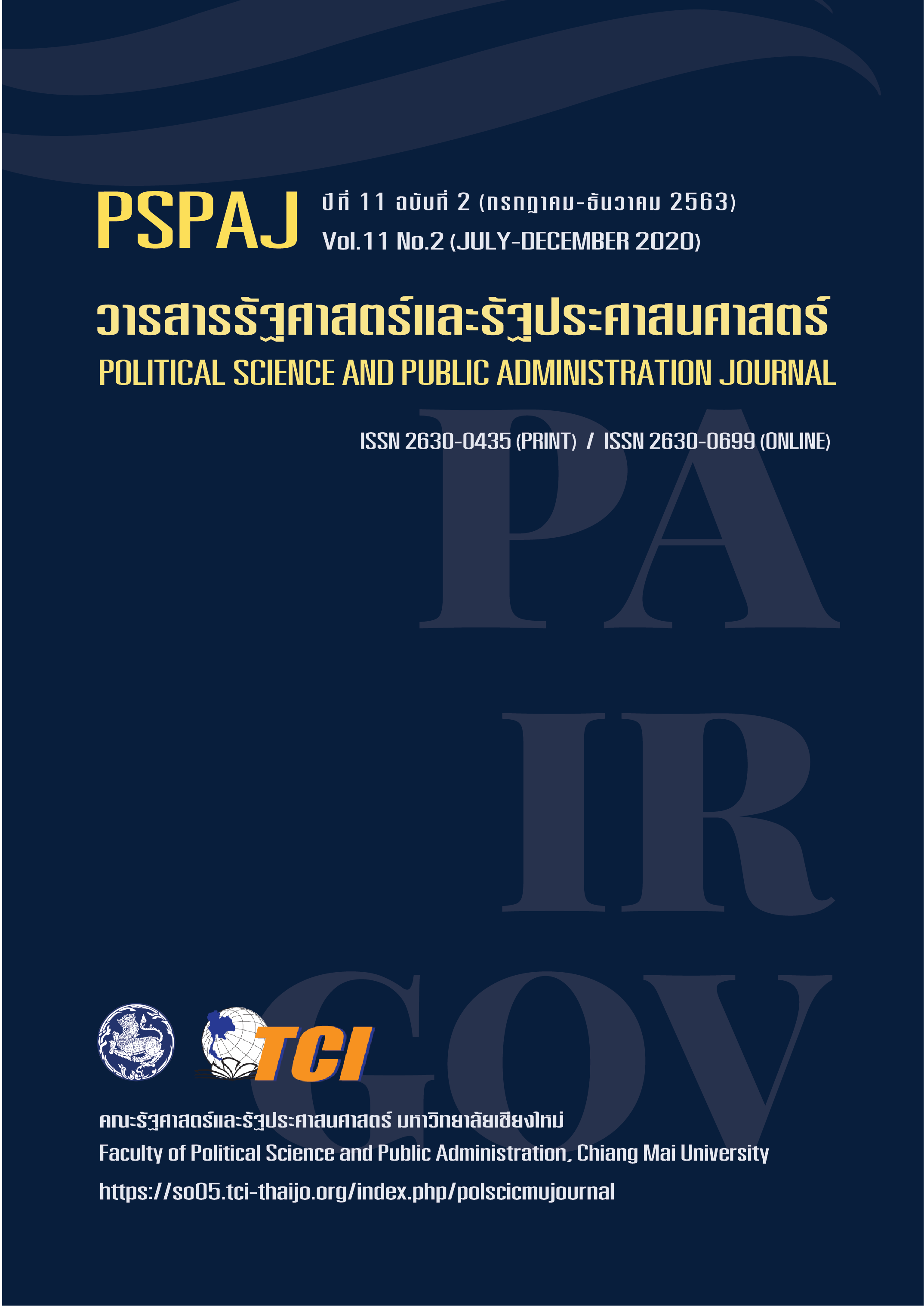Open the Black Box of Thai Higher Education
Main Article Content
Abstract
The objective of this research was to analyze the causal relationship between the black box and the performance of Thai higher education institutions through the employee engagement factor. The quantitative research instruments used in this study were questionnaires. The respondents were 1,992 academic staff from 6 Thai higher educational institutions, namely Chulalongkorn University, Mahidol University, Chiang Mai University, Thammasat University, Kasetsart University, and Suan Sunandha Rajabhat University. The sampling techniques used were quota sampling and accidental sampling. The demographic data of the respondents was analyzed using percentage, mean, standard deviation, skewness, and kurtosis. The AMOS program was used to analyze the reliability of all variables. The LISREL program was employed to analyze the validity of the measurement model. The research results found that the employees’ capability, motivation, and opportunity had a direct positive impact and an indirect impact on the performance of the higher education institutions through the employees’ engagement, which acted as a mediator variable. Therefore, it is essential for higher education institutions to place importance on human resource practices that help to enhance employees’ engagement and can contribute to organizational performance.
Article Details
- เนื้อหาและข้อมูลที่ลงตีพิมพ์ในวารสารรัฐศาสตร์และรัฐประศาสนศาสตร์ถือเป็นข้อคิดเห็นและความรับผิดชอบของผู้เขียนบทความโดยตรง ซึ่งกองบรรณาธิการวารสารรัฐศาสตร์และรัฐประศาสนศาสตร์ ไม่จำเป็นต้องเห็นด้วย หรือร่วมรับผิดชอบใดๆ
- บทความและข้อมูล ที่ได้รับการตีพิมพ์ในวารสารรัฐศาสตร์และรัฐประศาสนศาสตร์ ถือเป็นลิขสิทธิ์ของวารสาร หากบุคคลหรือหน่วยงานใดต้องการนำข้อมูลไปใช้ประโยชน์ในทางวิชาการ ขอให้อ้างอิงแหล่งที่มาด้วย
References
กฤษณะ สุกพันธ์, อิสราภรณ์ ทนุผล, และเนตรดาว ชัยเขต. (2559). รูปแบบค่าตอบแทนที่ส่งผลต่อผลการดำเนินงานของธุรกิจโรงแรมในเขตภาคตะวันออก. วารสารการจัดการธุรกิจ มหาวิทยาลัยบูรพา, 5(1), 1-14.
โชติรส ดำรงศานติ. (2554). การให้สิ่งจูงใจที่ไม่ใช่ตัวเงินและการสื่อสารของผู้นำที่มีผลต่อความรักและพลังขับเคลื่อนองค์การของคนเก่ง. (วิทยาศาสตรมหาบัณฑิต การพัฒนาทรัพยากรมนุษย์และองค์การ), สถาบันบัณฑิตพัฒนาบริหารศาสตร์.
ทรงยศ แก้วมงคล. (2555). ปัจจัยที่มีอิทธิพลต่อประสิทธิผลการบริหารงานวิชาการของโรงเรียนประถมศึกษาสังกัดกรุงเทพมหานคร. (วิทยานิพนธ์ปริญญาดุษฎีบัณฑิต), มหาวิทยาลัยเกษตรศาสตร์.
มะยุรี สุดตา, และธนัช กนกเทศ. (2553). ปัจจัยที่มีผลต่อความสำเร็จในการบริหารจัดการที่ดีขององค์กร ปกครองส่วนท้องถิ่น: กรณีศึกษา องค์การบริหาร ส่วนตำบลป่ามะคาบ อำเภอเมือง จังหวัดพิจิตร. (รัฐประศาสนศาสตรมหาบัณฑิต), มหาวิทยาลัยนเรศวร.
เยาวภา ปฐมศิริกุล. (2554). แบบจำลองปัจจัยความสำเร็จการจัดการธุรกิจบริการสุขภาพของโรงพยาบาล เอกชนในประเทศไทย. วารสารบริหารธุรกิจ, 34(130), 14-35.
วนิดา เหรียญจิโรจน์. (2553). ปัจจัยที่มีผลต่อความผูกพันองค์การของเจ้าหน้าที่สำนักงานสรรพากรพื้นที่สมุทรสาคร 1. (การค้นคว้าแบบอิสระปริญญามหาบัณฑิต), สาขาวิชาบริหารธุรกิจ มหาวิทยาลัยเชียงใหม่.
วัชรพงษ์ อินทรวงศ์. (2552). กล่องดำและแนวคิดวิธีปฏิบัติที่ดีที่สุดในการบริหารทรัพยากรมนุษย์. วารสารรัฐประศาสนศาสตร์, 8(1), 159-184.
______. (2552). อิทธิพลของวิธีปฏิบัติด้านทรัพยากรมนุษย์ต่อผลการปฏิบัติงานบุคลากรสายผู้สอนในสถาบันอุดมศึกษา. (วิทยานิพนธ์หลักสูตรรัฐประศาสนศาสตรดุษฎีบัณฑิต), คณะรัฐประศาสนศาสตร์ สถาบันบัณฑิตพัฒนบริหารศาสตร์.
วีระศักดิ์ พุทธาศรี, นุศราพร เกษสมบูรณ์, สุรศักดิ์ สุนทร, อรณัชชา เซ็นโส, ปิยะอร แดงพยนต์, และกนกวรรณ เส็งคำภา. (2554). การประเมินผล 10 ปี โรงพยาบาลบ้านแพ้ว (องค์การมหาชน). กรุงเทพฯ: สถาบันวิจัยระบบสาธารณสุข.
สำนักงานเลขาธิการสภาการศึกษา กระทรวงศึกษาธิการ. (2561). สถิติการศึกษาของประเทศไทย ปีการศึกษา 2559-2560. กรุงเทพฯ: พริกหวานกราฟฟิค.
Allen, M. R., & Wright, P. M. (2007). Strategic Management and HRM. In Boxall, P., Purcell, P., & Wright, P. (Eds.). The Oxford Handbook of Human Resource Management. United Kingdom: Oxford University Press.
Allen, N. J., & Meyer, J. P. (1990). The Measurement and Antecedents of Affective, Continuance and Normative Commitment to the Organization. Journal of Occupational Psychology, 63(1), 1-18.
Applebaum, E., Bailey, T., Berg, P., & Kalleberg, A. (2000). Manufacturing Advantage: Why High-Performance Work Systems Pay off. Ithaca: ILR Press.
Barney, J. B., Ketchen, D. J., & Wright, M. (2011). The Future of Resource-Based Theory: Revitalization or Decline? Journal of Management, 37(5), 1299-1315.
Belcourt, M., Bohlander, G. W., & Snell, S. (2008). Managing Human Resources. Toronto: Nelson.
Boxall, P., & Purcell, J. (2003). Strategy and Human Resource Management. Basingstoke: Palgrave Macmillan.
Cheng T., & Mohd A. (2011). Human Resource Management Practices and Organizational Innovation: Assessing the Mediating Role of Knowledge Management Effectiveness. Electronic Journal of Knowledge Management, 9(2), 155-167.
Cooper, K. E. (2009). Go with the flow: Examining the Effects of Engagement Using Flow Theory and Its Relationships to Achievement and Performance in the 3-dimensional Virtual Learning Environment of Second Life. (Doctoral Dissertation). University of Central Florida, College of Education.
Federman, B. (2009). Employee Engagement: A Roadmap for Creating Profits, Optimizing Performance, and Increasing Loyalty. San Fransisco: Jossey-Bass.
Guest, D. (1997). Human Resource Management and Performance: A Review and Research Agenda. International Journal of Human Resource Management, 8, 263-276.
Hair, J. F. Jr. Black, W. C., Babin, B. J. Anderson, R. E., & Tatham, R. L. (2006). Multivariate Data Analysis. New Jersey: Prentice Hall.
Huselid, M. (1995). The Impact of Human Resource Management Practices on Turnover, Productivity and Corporate Financial Performance. Academy of Management Journal, 38(3), 635-672.
Institute for Management Development. (2018). IMD World Competitiveness Yearbook 2018. Lausanne: Switzerland.
Jiang, K., Lepak, D. P., Hu, J., & Baer, J. C. (2012). How Does Human Resource Management Influence Organizational Outcomes? A Meta-Analytic Investigation of Mediating Mechanisms. Academy of Management Journal, 55(6), 1264-1294.
Prieto, M. I., & Pérez-Santana, P. M. (2014). Managing Innovative Work Behavior: The Role of Human Resource Practices. Personnel Review, 43(2), 184-208.
Steers, R. M. (1977). Antecedents and Outcomes of Organizational Commitment. Administrative Science Quarterly, 22(1), 46-56.
Taboada, A., Tonks, S. M., Wigfield, A., & Guthrie, J. T. (2009). Effects of Motivational and Cognitive Variables on Reading Comprehension. Reading and Writing: An Interdisciplinary Journal, 22(1), 85-106.
Takeuchi, R., Lepak, D. P., Wang, H., & Takeuchi, K. (2007). An Empirical Examination of the Mechanisms Mediating between High-Performance Work Systems and the Performance of Japanese Organizations. Journal of Applied Psychology, 92(4), 1069-1083.
Wright, P., McMahan, G., & McWilliams, A. (1994). Human Resource and Sustained Competitive Advantage: A Resource-Based Perspective. International Journal of Human Resource Management, 5(2), 301-326.
Yamane, T. (1973). Statistics an Introductory Analysis. New York: Harper & Row.


